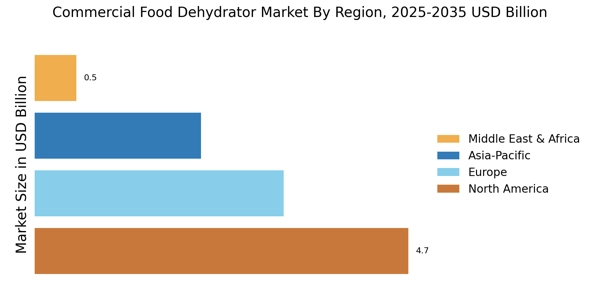The Commercial Food Dehydrator Market is currently characterized by a dynamic competitive landscape, driven by increasing consumer demand for healthy, preservative-free food options and the growing trend of home cooking. Key players such as Excalibur (US), Nesco (US), and Vitamix (US) are strategically positioned to leverage these trends through innovation and product diversification. Excalibur (US) has focused on enhancing its product line with advanced features that cater to both commercial and home users, while Nesco (US) emphasizes affordability and user-friendly designs, appealing to a broader consumer base. Vitamix (US), known for its high-performance blenders, is expanding its portfolio to include dehydrators, thereby integrating its brand into the health-conscious market segment. Collectively, these strategies contribute to a moderately fragmented market structure, where innovation and brand loyalty play crucial roles in shaping competitive dynamics.
In terms of business tactics, companies are increasingly localizing manufacturing to reduce costs and enhance supply chain efficiency. This approach not only mitigates risks associated with The Commercial Food Dehydrator Market demands. The competitive structure of the market remains moderately fragmented, with several players vying for market share. The collective influence of these key players fosters a competitive environment where differentiation is achieved through product quality, technological advancements, and customer service.
In August 2025, Excalibur (US) launched a new line of commercial-grade dehydrators designed specifically for restaurants and food service operations. This strategic move is significant as it positions Excalibur to capture a larger share of the professional market, which is increasingly seeking efficient and reliable food preservation methods. By catering to this niche, Excalibur not only enhances its brand reputation but also solidifies its presence in a growing segment of the food industry.
In September 2025, Vitamix (US) announced a partnership with a leading organic food supplier to develop dehydrated meal kits. This collaboration is noteworthy as it aligns with the rising consumer preference for convenient, healthy meal options. By integrating dehydrators into meal preparation, Vitamix is likely to enhance its market appeal and drive sales, while also promoting a sustainable approach to food consumption.
In October 2025, Nesco (US) unveiled a new digital marketing campaign aimed at educating consumers about the benefits of food dehydration. This initiative is crucial as it not only raises awareness about the health benefits of dehydrated foods but also positions Nesco as a thought leader in the market. By focusing on consumer education, Nesco may strengthen its brand loyalty and encourage repeat purchases, thereby enhancing its competitive edge.
As of October 2025, the competitive trends in the Commercial Food Dehydrator Market are increasingly defined by digitalization, sustainability, and the integration of artificial intelligence in product development. Strategic alliances, such as those seen between Vitamix (US) and organic suppliers, are shaping the landscape by fostering innovation and expanding product offerings. Looking ahead, competitive differentiation is expected to evolve from traditional price-based competition to a focus on innovation, technology integration, and supply chain reliability. Companies that can effectively leverage these trends are likely to emerge as leaders in the market.


















Leave a Comment